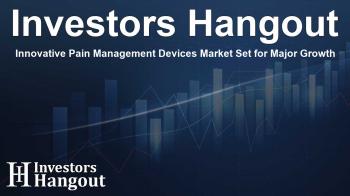Innovative Pain Management Devices Market Set for Major Growth

The Evolution of the Pain Management Devices Market
In recent years, the global pain management devices market has demonstrated exceptional growth potential. Analysts project that by a future date, the market will reach approximately USD 5,727.5 million, growing at a remarkable CAGR of 6.6% from previous estimates of around USD 3,019.8 million. As healthcare technology advances, pain management solutions have become faster, safer, and more effective, meeting a rising demand for non-pharmaceutical treatments.
The Rise of Neurostimulation Technology
Transforming Pain Relief Approaches
One of the significant advancements in this sector is the increase in popularity of neurostimulation devices. These tools provide targeted pain relief for conditions ranging from chronic pain disorders to acute pain, significantly reducing reliance on pharmaceutical alternatives.
Impacts of Opioid Addiction Challenges
The opioid crisis is shifting focus toward innovative pain relief solutions. The ongoing concerns over dependency have catalyzed the demand for alternative treatments, which is reflected in the growing sales of non-invasive pain management devices.
Technological Advancements Shaping the Market
Innovations in Device Functionality
Recent technological innovations are enriching the patient experience in pain management. The infusion of artificial intelligence (AI) and machine learning (ML) has facilitated real-time monitoring and personalized treatment options, enhancing the efficacy of treatments offered to patients. Additionally, integration with wireless technology allows for app-based controls, enabling users to adjust device settings easily.
The Shift Toward Wearable Solutions
Wearable pain management devices are also gaining traction, allowing patients to manage pain discreetly and throughout their daily activities. These devices are lightweight, portable, and designed to offer relief while maintaining user comfort, empowering patients in their recovery journeys.
Market Insights and Growth Opportunities
Market Growth Drivers
Several factors are catalyzing the growth of the pain management devices market. The persistent rise in chronic pain conditions, including neuropathic and musculoskeletal disorders, drives increased adoption. Moreover, technological innovations contribute significantly, ensuring that solutions are both effective and accessible.
Geographic Market Dynamics
Regions experiencing heightened growth include North America and parts of Asia-Pacific, where healthcare investments are surging. The increasing elderly demographic in these regions is reflected in rising demand for chronic pain solutions, allowing companies to tap into new markets and build comprehensive offerings. Countries like India and China exhibit strong growth prospects due to improving healthcare frameworks and increasing awareness of advanced medical technologies.
The Future Outlook
Integration of IoT in Pain Management
The integration of the Internet of Things (IoT) is fueling further advancements in pain management devices. By connecting different healthcare systems and enabling real-time patient data sharing, these devices provide healthcare providers with crucial insights that help in making informed treatment decisions.
New Research and Development Initiatives
As researchers continue to explore novel pain treatment methods, organizations are investing heavily in R&D. Companies are focused on developing cutting-edge technologies that not only enhance patient quality of life but also streamline operational efficiency.
Frequently Asked Questions
What is the current projection for the pain management devices market?
Experts project that the market will reach around USD 5.7 billion, growing at a CAGR of 6.6% due to technological advancements and increasing chronic pain cases.
How are technological innovations influencing pain management?
Technological advancements, including AI and IoT, are enhancing device functionality, allowing real-time monitoring, personalized treatment options, and improved patient engagement.
What role does neurostimulation play in modern pain relief?
Neurostimulation devices are leading the market by providing targeted pain relief, reducing the need for opioids, and offering non-invasive treatment alternatives.
How is the market evolving in response to the opioid crisis?
The opioid crisis has heightened demand for non-pharmaceutical alternatives, boosting the adoption of pain management devices that focus on non-invasive solutions.
What opportunities exist for new entrants in the market?
With a growing demand for innovative pain management solutions and the introduction of advanced technologies, there are vast opportunities for new players to enter and thrive in this market.
About The Author
Contact Hannah Lewis privately here. Or send an email with ATTN: Hannah Lewis as the subject to contact@investorshangout.com.
About Investors Hangout
Investors Hangout is a leading online stock forum for financial discussion and learning, offering a wide range of free tools and resources. It draws in traders of all levels, who exchange market knowledge, investigate trading tactics, and keep an eye on industry developments in real time. Featuring financial articles, stock message boards, quotes, charts, company profiles, and live news updates. Through cooperative learning and a wealth of informational resources, it helps users from novices creating their first portfolios to experts honing their techniques. Join Investors Hangout today: https://investorshangout.com/
The content of this article is based on factual, publicly available information and does not represent legal, financial, or investment advice. Investors Hangout does not offer financial advice, and the author is not a licensed financial advisor. Consult a qualified advisor before making any financial or investment decisions based on this article. This article should not be considered advice to purchase, sell, or hold any securities or other investments. If any of the material provided here is inaccurate, please contact us for corrections.

